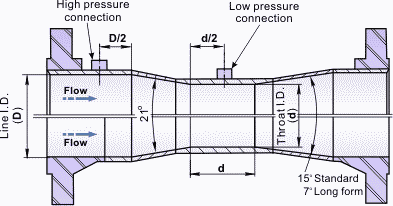I didn't do enough research and I didn't listen to my conscience. I was rushing to get things done...this is what happens when one rushes things.
Rather than dwell on my mistakes I shall design a new and better and hopefully more correct venturi tube. I wasn't aware of this but there is an ISO standard for venturi tubes. It is based upon a British Standard:
BS 7405:1991
Unfortunately I cannot look at this standard as I do not have access to it and I cannot afford to buy it. It costs £392 to non members and £196 to members of the British Standards Institute.
It would be free for me to view at my local central library however I cannot access my nearest central library in lock down...
Helpfully a diagram has been reproduced which shows the pertinent mechanical details:
 |
| Image Credit: http://thermopedia.com/content/1241/ |
So what does the diagram tell us:
1. The high pressure portion of the venturi tube must be separated from the throat portion of the tube by a 21° sloping draft section.
2. The exit section shall have a 15° draft section and shall be longer than the high pressure portion.
3. The throad section shall have a specified width (d).
4. The low pressure measurement port position (Throat) shall be fixed at half the dimension of the length of the section. (d/2)
5. The high pressure measurement port position shall be fixed at half the dimension of the length of the section. (D/2)
6. The throat internal diamter shall be fixed and the same as the length of the section (d).
7. The high pressure diameter shall be fixed and the same as the length of the section (D).
It is no surprise my design didn't work as well as expected...it was not designed properly...hey ho. Lets mark up the diagram and then draw a new version of the venturi tube and get it 3D printed...
Here is the new design taking into account the information we now have:
Here is a render of how it might look when printed:
So...the plan is to print yet another tube and calculate it's response and then test it and hope that it's response will be good enough. Iterating on designs is how improvements are made. I should add that mechanical design of instrumentation is not my area of expertise and I'm applying what I have learned from research. I have no real experience in designing venturi tubes!
I used the following sites to help me:
That's all for now! Take care - Langster!

How is the design coming ... I have been following all of your posts and most curious!
ReplyDeleteHi,
DeleteI have printed and tested the tube and it does appear to work. I can only compare to my previous attempts but seems to be fine. I haven't had much time to work on this as a lot has happened since I wrote this and the subsequent posts.
Thank you for commenting
Hi
DeleteFinished it...thought you might be interested. It required a different sensor and I used a different arrangement of tubes in the venturi....
https://www.instructables.com/3D-Printed-Spirometer/